
Geranium is a genus of 422 species of annual, biennial, and perennial plants that are commonly known as geraniums or cranesbills. They are found throughout the temperate regions of the world and the mountains of the tropics, but mostly in the eastern part of the Mediterranean region.

Geranium maderense, known as giant herb-Robert or the Madeira cranesbill, is a species of flowering plant in the family Geraniaceae, native to the island of Madeira. It is sometimes confused with another Madeira endemic, Geranium palmatum.

Geranium × magnificum, the purple cranesbill, is a species of hardy flowering herbaceous perennial plant in the genus Geranium, family Geraniaceae. The multiplication symbol × indicates that it is the result of hybridisation, in this case between Geranium platypetalum and Geranium ibericum. Growing into a clump 70 cm (28 in) high and broad, it has the decorative, deeply-lobed leaves typical of the genus Geranium. Violet-blue flowers with darker veins are borne relatively briefly in early summer. Extremely hardy, to below −20 °C (−4 °F), it is suitable for cultivation throughout all temperate regions. This plant has gained the Royal Horticultural Society's Award of Garden Merit.
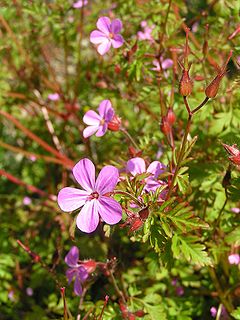
Geranium robertianum, commonly known as herb-Robert, red robin, death come quickly, storksbill, fox geranium, stinking Bob, squinter-pip (Shropshire), crow's foot, or Roberts geranium, is a common species of cranesbill native to Europe and parts of Asia, North America, and North Africa.

Rodale, Inc. was an American publisher of health and wellness magazines, books, and digital properties. Rodale was headquartered in Emmaus, Pennsylvania and maintained a satellite office in New York City. It published health and wellness lifestyle magazines, including Men's Health and Prevention. The company published a collection of bestsellers, including An Inconvenient Truth and Eat This, Not That.

Geranium sanguineum, common names bloody crane's-bill or bloody geranium, is a species of hardy flowering herbaceous perennial plant in the cranesbill family Geraniaceae. It is also the county flower of Northumberland.

Prevention is an American healthy-lifestyle magazine published by Hearst Corporation featuring articles about health conditions, wellness, food and nutrition, weight loss, fitness, and beauty.

Geranium dissectum or Cut-leaved Crane's-bill is a plant species of the genus Geranium. It is native to Europe.
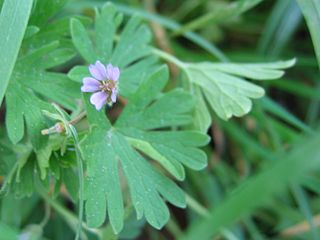
Geranium pusillum, commonly known as small-flowered crane's-bill or small geranium, is a herbaceous annual plant of the genus Geranium.
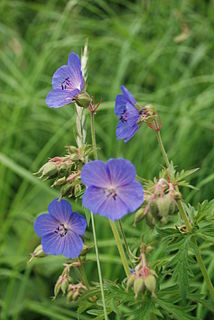
Geranium pratense, the meadow crane's-bill or meadow geranium, is a species of flowering plant in the family Geraniaceae, native to Europe and Asia. Forming a clump roughly 1 m (3.3 ft) tall and broad, it is a herbaceous perennial with hairy stems and lax saucer-shaped blooms of pale violet. It is extremely hardy to at least −20 °C (−4 °F), reflecting its origins in the Altai Mountains of central Asia.

Geranium macrorrhizum is a species of hardy flowering herbaceous perennial plant in the genus Geranium, family Geraniaceae. It is native to the South east Alps and the Balkans. Its common names include bigroot geranium, Bulgarian geranium, and rock crane's-bill.

Geranium clarkei, called Clarke's geranium, is a species of flowering plant in the family Geraniaceae, native to India and cultivated for use in gardens.

Geranium dalmaticum, commonly called Dalmatian cranesbill, is a species of hardy flowering herbaceous perennial plant in the genus Geranium of the family Geraniaceae. It is native to Dalmatia on the west coast of Croatia. Growing to only 10 cm (3.9 in) tall by up to 50 cm (20 in) broad, it is cultivated as a garden subject in temperate regions for its low mound of aromatic leaves and soft mauve colored flowers. The palmately lobed glossy green leaves are tinted red in the Autumn. It has gained the Royal Horticultural Society's Award of Garden Merit.

Geranium endressii, commonly called Endres cranesbill or French crane's-bill, is a species of hardy flowering herbaceous or semi-evergreen perennial plant in the genus Geranium, family Geraniaceae.

Geranium himalayense is a species of hardy flowering herbaceous perennial plant in the genus Geranium, family Geraniaceae. It is native to the Himalayas, parts of Russia and western China.
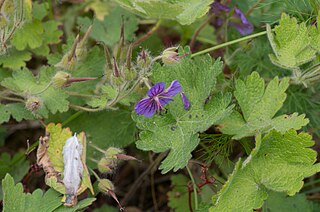
Geranium ibericum, commonly called Caucasian crane's-bill or Iberian geranium or Caucasus geranium, is a herbaceous plant species in the family Geraniaceae. It is native to Western Asia, including Turkey and the Caucasus, and is cultivated as a garden subject. It has a dense mounding habit, and violet colored flowers.

Geranium phaeum, commonly called dusky crane's-bill, mourning widow or black widow, is a herbaceous plant species in the family Geraniaceae. It is native to southern, central, and western Europe, and is cultivated as a garden subject. It has dark violet colored flowers. It is unmistakable with dark purple petals turned backwards and with conspicuous projecting stamens and style. Petals crinkly-edged and pointed. Leaves often blotched brown.

Geranium psilostemon, commonly called Armenian cranesbill, is a species of hardy flowering herbaceous perennial plant in the genus Geranium, family Geraniaceae. It is native to Turkey, Armenia, Azerbaijan, and the Russian Federation. Forming a large clump to 120 cm (47 in) tall, it has glowing reddish purple colored flowers with prominent dark centres, and divided leaves tinted red in Autumn. It is cultivated as a garden subject, and a number of different cultivars exist. G. psilostemon has the UK’s hardiest rating, surviving temperatures as low as −20 °C (−4 °F).
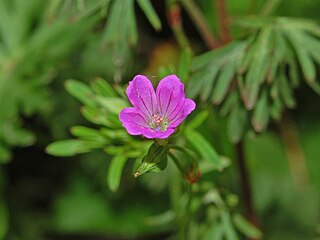
Geranium columbinum, common name long-stalked crane's-bill or longstalk cranesbill, is a herbaceous annual plant in the family Geraniaceae.

Geranium purpureum, the little-robin, is a species of plant in the genus Geranium.



















